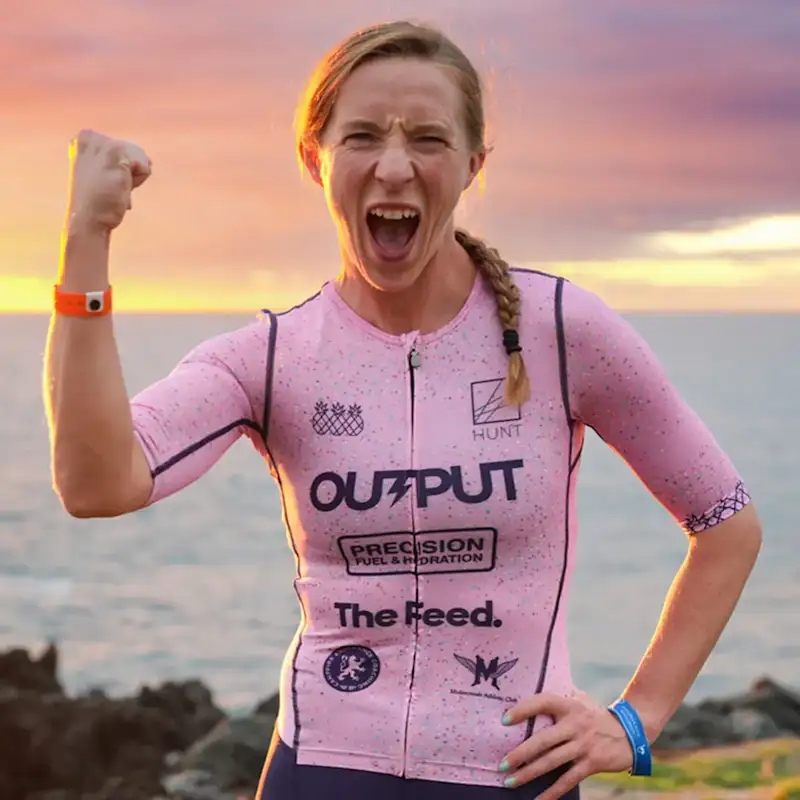
Fiona Moriarty
IRONMAN® Brasil
Fiona's headline numbers
Fiona's strategy
Fueling
Carbohydrate is the main fuel you burn when racing. Failing to fuel properly is a leading cause of underperformance in longer races.
Fiona had her best race in a lot of ways, especially when it came to fueling. She managed to carb-load sufficiently in the days prior without issue, noting it felt like her body “knew I was about to do a big, dumb race and absorbed every carb it could”. With her standard breakfast and final top up of a PF 30 Chew before the swim, she headed into the bike with solid energy availability. Once settled, she took in just over one-and-a-half pouches of Flow Gel plus two additional PF 30 Chews, an execution she’s extremely proud of - and rightfully so! The run started off strong, but shortly after she picked up her second round of soft flasks, someone knocked the one with Flow Gel out of her hand. From there, she relied solely on cola, which did not go well for her sensitive stomach, between the carbonation, caffeine and carb content. She has noticed responding much better to separating her carbs from her fluid sources, so having to combine them through cola was less than ideal, and she had to make four bathroom stops in the final 14 miles, ultimately costing her the win.
Hydration
Taking on board an appropriate amount of fluid and sodium is essential to maintaining blood volume and supporting the cardiovascular effort needed to perform on race day.
Whilst the absolute amount of sodium and fluid consumed per hour is important, it’s critical to consider these in relation to each other. This is known as 'relative sodium concentration' and it’s expressed in milligrams per litre (mg/L). How much sodium you’re taking in per litre of fluid is more important than the absolute amount taken in per hour.
Sweat sodium concentration (mg/L) is largely genetically determined and remains relatively stable. Knowing how salty your sweat is enables you to replace a good proportion of your sweat losses, which can range from 200-2,000mg/L.
Given Fiona’s losses are High (1,146mg/L), nailing her hydration strategy remains important, even when it’s Mild.
Learn moreFiona nailed her hydration at this race, hitting the top end of the recommendations for fluid intake in a race of these conditions. She started with PH 1000 (Tablets) in her bottles, refilling with additional tablets and water throughout the race. Using this ‘decoupled’ strategy of keeping her fuel intake separate from her hydration works well for her, particularly in full-distance IRONMAN® races. So when she had to use cola on the run, a very ‘coupled’ strategy of carbs in fluids, she struggled. Thankfully she was still able to take in sodium through her extra PH 1000 tablets she put in her soft flask, but she may have been better off with a little less cola and more plain water mixed with the tablets to dilute it down… though this would have cost her some fuel!
Caffeine
Beyond the Three Levers of Performance (carb, sodium and fluid), caffeine is one of only a few substances that is proven to improve performance for most endurance athletes as it can help stave off mental and physical fatigue.
Caffeine is a common part of endurance athletes’ strategies, but Fiona’s struggled to tolerate it with her sensitive GI in past races. Her morning pre-race coffee will have given her a bit of the stimulant, and then the unplanned reliance on cola for the second half of the run ended up giving her more than she’s used to. In the future, since she does seem to be sensitive to caffeine’s effects, she could trial small doses in training, perhaps starting with a PF 30 Caffeine Gel mixed into her Flow Gel flask, and see how it goes. But, even though caffeine is a well-researched ergogenic aid, it’s not a make-or-break piece of the puzzle and individual tolerance should be the deciding factor in the end.
How Fiona hit her numbers
Here's everything that Fiona ate and drank on the day...
Fiona's weapons of choice
Final thoughts
Fiona's full stats
Data Confidence?
There is an adequate level of accuracy in the data collected and the numbers reported. The athlete manages to recall what they ate and drank including most specifics (brands flavours quantities plausible estimations of volumes). However there are estimations made within the data which affect the overall confidence level in the data reported.